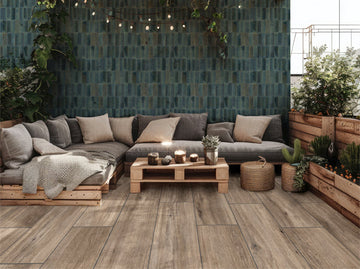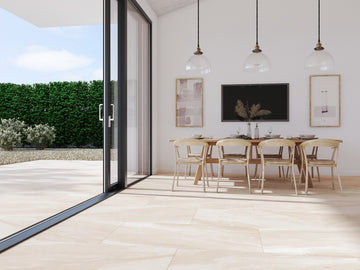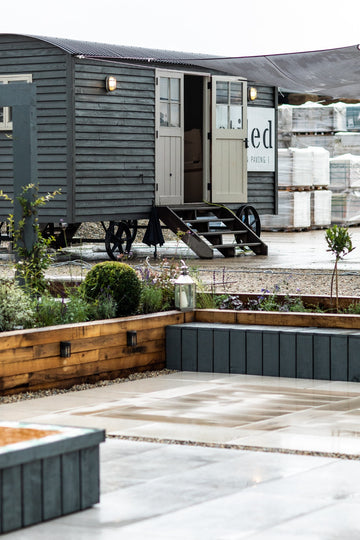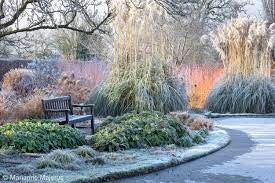News
Sustainable Landscaping: 16 Sustainable Design Tips for a Garden
by Sally Littlestone on Mar 12, 2023
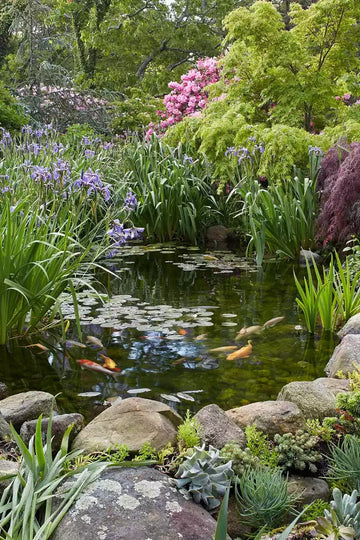
Landscaping can be a fun and rewarding activity, but it can also have a significant impact on the environment. Sustainable landscaping is a way to create a beautiful garden that is also environmentally friendly. Here are 16 sustainable landscaping ideas for your garden that can help you design a beautiful and eco-friendly space.

Use Native Plants:
When it comes to sustainable landscaping, using native plants is a smart choice. Native plants are adapted to the local environment and are more resistant to pests and diseases, which means they require less water, fertilizer, and pesticides than non-native plants. They also provide food and habitat for local wildlife, including birds and insects, which can help create a more biodiverse ecosystem in your yard. By using native plants in your landscaping, you can reduce your water usage, lower your maintenance costs, and help support the local ecosystem. Plus, native plants often have unique and beautiful features that can add to the aesthetic appeal of your landscaping. So, whether you're starting a new landscaping project or looking to update your existing yard, consider using native plants to create a sustainable and beautiful outdoor space.

Plant Drought-Tolerant Species
Sustainable landscaping is all about creating a beautiful and functional outdoor space while also minimizing the impact on the environment. One way to achieve this is by planting drought-tolerant species. These plants are able to thrive in areas with limited water, which can help reduce the amount of water needed for irrigation. By using less water, you can save money on your water bill and conserve a valuable resource. Drought-tolerant species also tend to be hardier and more resistant to pests and diseases, which means they require less maintenance and fewer chemical inputs like fertilizers and pesticides. Plus, they can add texture, color, and interest to your landscaping, making them a great choice for any outdoor space. So, if you're looking to create a sustainable and low-maintenance landscape, consider planting drought-tolerant species.

Image - Ideal Home
Use Rain Barrels
Another great way to create a sustainable landscape is by using rain barrels. Rainwater harvesting is a simple and effective way to reduce your water usage and minimize runoff. By collecting rainwater in barrels or other containers, you can store the water for use in your garden or yard during dry periods. This not only reduces your reliance on municipal water sources, but it also helps to minimize stormwater runoff, which can carry pollutants and other contaminants into nearby streams and rivers. Rain barrels are relatively easy to install and can be purchased in a variety of sizes and styles to fit your specific needs. Plus, by using rainwater in your garden, you're providing your plants with a natural source of water that is free of chlorine and other chemicals often found in tap water. So, if you're looking to create a more sustainable landscape, consider using rain barrels to collect and store rainwater for use in your garden or yard.

Image - Gardening Knowhow
Install A Drip Irrigation System
Drip irrigation is a type of irrigation system that delivers water directly to the base of plants through a network of tubes and emitters. This method of irrigation is more efficient than traditional sprinkler systems, as it minimizes water loss due to evaporation, runoff, and overspray. Additionally, drip irrigation systems can be customized to deliver water only where it's needed, which means you can use less water overall. By reducing your water usage, you'll not only save money on your water bill but also help to conserve a precious resource. Drip irrigation systems can be installed in both small and large landscapes and are suitable for a wide variety of plants, including trees, shrubs, and vegetables. So, if you're looking to create a sustainable landscape that is both beautiful and efficient, consider installing a drip irrigation system.

Image - Gardening Etc
Plant Trees
Planting trees is an excellent way to create a more sustainable landscape. Trees provide a wide range of environmental, social, and economic benefits, including shade, air purification, erosion control, and wildlife habitat. By planting trees, you can help to reduce the urban heat island effect, which is caused by the heat-absorbing properties of pavement and other surfaces in cities. Additionally, trees absorb carbon dioxide from the atmosphere, which can help to mitigate the effects of climate change. Planting trees also adds aesthetic value to your landscape and can increase property values. When selecting trees to plant, be sure to choose species that are well-suited to your climate and soil conditions. Consider factors such as mature size, growth rate, and water requirements when making your selection. By planting trees, you'll be creating a more sustainable and beautiful landscape for years to come.

Create Compost
Creating compost is a simple and effective way to reduce your waste and create a more sustainable landscape. Compost is made from organic materials such as yard waste, food scraps, and leaves, which are broken down by microorganisms into a nutrient-rich soil amendment. By composting your yard and kitchen waste, you can divert these materials from the landfill, where they contribute to greenhouse gas emissions. Additionally, compost helps to improve soil structure and fertility, which can benefit your plants and reduce the need for synthetic fertilizers. Composting can be done in a variety of ways, including using a bin or pile in your yard, or by using a compost tumbler or worm bin. By creating compost, you'll be contributing to a healthier environment and a more sustainable landscape.
Choose Perennial Plants
Choosing perennial plants is a smart and sustainable choice when it comes to landscaping. Perennial plants are those that come back year after year, unlike annuals which must be replanted each year. By choosing perennial plants, you can reduce the amount of time and resources needed for replanting, which can save you both time and money. Additionally, perennial plants tend to have deeper root systems than annuals, which allows them to access water and nutrients from deeper in the soil, making them more resilient to drought and other environmental stressors. Perennial plants also tend to be low-maintenance, which means they require less watering, fertilizing, and pest control than many annuals. When selecting perennial plants, be sure to choose varieties that are well-suited to your climate and soil conditions. By choosing perennial plants, you'll be creating a more sustainable landscape that requires less maintenance and provides beauty and biodiversity for years to come.

Image - Gardening Chores
Use Porcelain Tiles For Hard Landscaping
Outdoor porcelain tiles are considered to be a more sustainable choice for outdoor flooring than other tile options. This is because porcelain is made from natural materials, including clay, feldspar, and silica, which are abundant and easily replenished. Porcelain tiles are also manufactured using a process that produces very little waste and consumes less energy than other tile options. Additionally, porcelain tiles are extremely durable and long-lasting, which means they require less frequent replacement than other types of tiles. This reduces the amount of waste generated by replacing worn or damaged tiles, and also reduces the environmental impact of producing and transporting new tiles. Finally, porcelain tiles are non-porous, which means they do not require sealing or chemical treatments to maintain their appearance, further reducing the environmental impact of their maintenance. Overall, choosing outdoor porcelain tiles is a sustainable choice that supports environmental stewardship while also providing a durable and beautiful outdoor flooring option.

Use Mulch
Mulch is a layer of material, such as wood chips, leaves, or grass clippings, that is applied to the surface of the soil around plants. Mulch provides a number of benefits, including weed suppression, moisture retention, and temperature moderation. By suppressing weeds, mulch reduces the need for herbicides and manual weeding, which saves time and reduces the use of chemicals. Additionally, mulch helps to retain moisture in the soil, which reduces the need for watering and can help to conserve water. By moderating soil temperature, mulch can also protect plant roots from extreme heat and cold. When choosing mulch, be sure to select materials that are appropriate for your climate and soil conditions. Organic mulches, such as wood chips or leaves, will also break down over time, providing nutrients to the soil and improving soil structure. By using mulch, you'll be creating a more sustainable landscape that is both beautiful and efficient.
Install A Green Roof
Installing a green roof is an innovative and sustainable landscaping technique that can have a big impact on the environment. A green roof is a layer of vegetation and soil that is installed on top of a building's roof. Green roofs offer a wide range of benefits, including reducing the urban heat island effect, improving air quality, and reducing stormwater runoff. By absorbing and filtering rainwater, green roofs can help to reduce the amount of water that enters the stormwater system, which can help to prevent flooding and improve water quality. Additionally, green roofs can provide insulation, which can help to reduce heating and cooling costs. Green roofs also provide habitat for birds and insects, which can help to promote biodiversity in urban areas. When installing a green roof, it's important to choose plants that are well-suited to your climate and can tolerate the conditions on a rooftop, such as high winds and direct sunlight. By installing a green roof, you'll be creating a sustainable and beautiful landscape that can benefit both your property and the environment.

Image - Roof Giant
Use Solar Lighting
Using solar lighting is a great way to create a sustainable landscape while also enhancing the beauty and functionality of your outdoor space. Solar lighting uses solar panels to convert sunlight into electricity, which is then used to power outdoor lights. By using solar lighting, you can reduce your energy consumption and save money on your electricity bill. Additionally, solar lighting is easy to install and requires no wiring, which makes it a great option for remote or hard-to-reach areas. Solar lights come in a variety of styles, including path lights, spotlights, and string lights, which can add a warm and inviting atmosphere to your outdoor space. When selecting solar lights, be sure to choose high-quality products that are well-suited to your needs and climate. By using solar lighting, you'll be creating a sustainable landscape that is both functional and beautiful, while also reducing your impact on the environment.

Image - Houzz
Create A Rain Garden
Creating a rain garden is an excellent way to create a sustainable landscape that helps to manage stormwater runoff. A rain garden is a shallow depression that is planted with a variety of native plants, which helps to absorb and filter rainwater that runs off of roofs, driveways, and other hard surfaces. By creating a rain garden, you can reduce the amount of stormwater runoff that enters the stormwater system, which can help to prevent flooding and improve water quality. Rain gardens also provide habitat for birds and insects, which can help to promote biodiversity in urban areas. When creating a rain garden, it's important to choose plants that are well-suited to your climate and soil conditions, and to ensure that the garden is located in an area that receives adequate sunlight and drainage. By creating a rain garden, you'll be creating a sustainable and beautiful landscape that can benefit both your property and the environment.

Image - Financial Times
Use Recycled Materials
Using recycled materials is an excellent way to create a sustainable landscape that reduces waste and conserves natural resources. Recycled materials can include a variety of products, such as reclaimed wood, recycled plastic, and recycled glass. By using recycled materials, you can reduce the amount of waste that ends up in landfills, and you can also conserve natural resources by using materials that have already been extracted and processed. Additionally, many recycled materials are durable and long-lasting, which can reduce the need for frequent replacement and maintenance. When using recycled materials, it's important to choose products that are of high quality and are appropriate for your specific application. By using recycled materials in your landscape, you'll be creating a sustainable and beautiful space that benefits both your property and the environment.

Image - Pallet garden from Pinterest
Avoid Chemical Pesticides
Avoiding chemical pesticides is an important aspect of sustainable landscaping. Chemical pesticides can harm not only the pests they are intended to control but also other wildlife, such as bees, birds, and beneficial insects. They can also leach into soil and groundwater, potentially causing harm to the environment and human health. Instead of using chemical pesticides, consider using natural alternatives such as companion planting, which involves planting specific combinations of plants that naturally repel pests or attract beneficial insects. You can also manually remove pests or use physical barriers to prevent them from accessing your plants. By avoiding chemical pesticides, you'll be creating a sustainable landscape that is safer for both the environment and your family.
Create A Habitat For Wildlife
Creating a habitat for wildlife is an essential component of sustainable landscaping. By providing food, water, shelter, and nesting areas for birds, insects, and other wildlife, you can help to promote biodiversity and support local ecosystems. One way to create a habitat for wildlife is to plant native plants that are well-suited to the local climate and soil conditions. Native plants provide food and shelter for a variety of wildlife, including birds, bees, butterflies, and other beneficial insects. You can also include features such as bird feeders, birdbaths, and nesting boxes to attract and support wildlife. Additionally, you can create habitat areas such as meadows or wetlands, which can provide important habitats for a variety of species. By creating a habitat for wildlife, you'll be creating a sustainable landscape that benefits both the environment and your property, while also providing an opportunity to observe and enjoy the beauty of nature.

Image - Wildlife Garden
Design For Longevity
Designing for longevity is an important principle of sustainable landscaping. By choosing durable materials and designing with a long-term perspective in mind, you can create a landscape that requires less maintenance and lasts for many years. This approach helps to reduce the amount of waste generated by frequent replacements and repairs. When designing your landscape, choose materials that are durable and long-lasting, such as stone, concrete, and metal. Consider using native plants that are adapted to local conditions and require less water and maintenance than non-native species. Additionally, plan for the future by considering how your landscape will grow and change over time, and choose plants and materials that can adapt to these changes. By designing for longevity, you'll be creating a sustainable landscape that is both beautiful and low-maintenance, while also reducing the environmental impact of your landscaping choices.
Conclusion
Creating a sustainable garden can be a rewarding and environmentally friendly way to enjoy your outdoor space. By incorporating these sustainable landscaping ideas into your garden design, you can reduce your impact on the environment while creating a beautiful and functional space. Use these tips as a guide to create a garden that is both sustainable and visually appealing.
If you like this post, then you will also like
Related Articles


